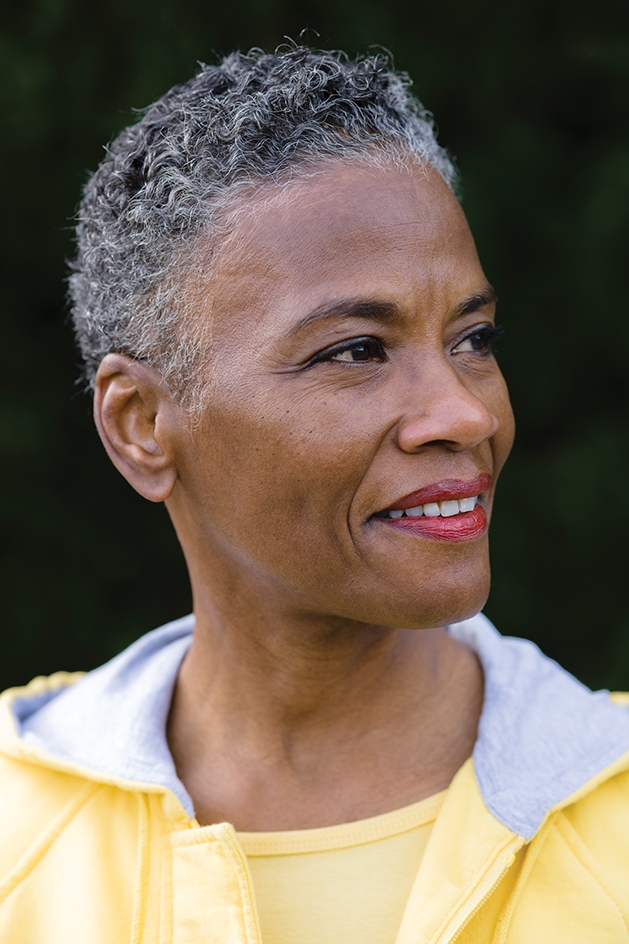
There is a growing movement of women emboldened by shifting beauty standards to embrace their graying hair. Celebs like Sarah Jessica Parker and Andie MacDowell stepped out of quarantine with naturally silver coiffures. Actress Cynthia Nixon (AKA: Sex and the City’s Miranda Hobbs) eschewed her once-red tresses for a natural gray style, and the change was included in the show’s reboot And Just Like That … The world took note.
Gray hair wannabes have discovered their soul-sisters on social media, where hashtags like #GrayHairDontCare, #SilverSisters and #GrayHairRevolution stoke camaraderie and acceptance.
Master colorist Lindsey Yozamp, hair color director at Wayzata’s Juut Salon Spa, and hairdresser Sue Craig with Minnetonka’s Hair Proź Salon explain how they guide clients through the transition and what people can expect when they decide to embrace their gray hair.

Photo: iStock.com/KaterynaOnyshchuk; Ann Bailey
“Most people find it life changing. They like their hair better and are not chained to the salon. The days of a three-week stripe are over.”
Lindsey Yozamp, hair color director at Wayzata’s Juut Salon Spa
Are more clients accepting their gray hair?
LY: I am definitely seeing more women embrace their gray. There is less need to cover every piece. Many clients are choosing their natural base. We add in dimension to keep things blended and on trend. This prevents banding and outgrowth … With the hair color trends living tonally in ash and icy, now more than ever gray hair is desirable …
Some say the COVID-19 pandemic led us to review our beauty standards and needs.
LY: The pandemic gave women a chance to see what they were really growing. Many of my guests had no idea what their natural color even was. The social stigma around out-growth “roots” was gone for a moment, creating a transitional opportunity for change.
How do you help clients through the process?
LY: The first step to embracing your gray is cooling down your hair color. Changing the tone can be one of the more dramatic transitions and can help you decide if you are headed in the right direction. After that, [eliminate] a permanent base color with a series of highlights and lowlights with an all-over demi gloss. (If you are thinking of going gray, consider a consultation with your colorist. It may take a series of services to achieve your goal.)
What advice to you have for those considering it?
SC: I always love encouraging change for my clients, but in these cases, I start with, “Relax. We are just exploring and gathering/exchanging information. We don’t need to do this today or even at your next visit.”
Once gray, do you encourage some color treatment to keep hair looking lively?
LY: Once gray, most of my guests see me seasonally or twice a year. Often, we add highlights or balance out uneven color. Glossing and Aveda’s blonde revival system is a must ... eliminating unwanted gold and dullness.
What if a client doesn’t like the result?
SC: I reassure [them] that I can always take them back if anyone discovers, “I guess I’m not ready.” Because, oftentimes, they don’t realize what 25 percent or 70 percent gray [hair] will look like once a couple of inches reveals itself. That’s the beauty of color … you can always change the direction or simply go back and try again in the future.
Juut Salon Spa, 1125 Wayzata Blvd. E., Wayzata; 952.404.9955; juut.com
Juut Salon Spa @juutsalonspa
@juutsalonspa
Hair Proź Salon, 14415 Excelsior Blvd., Minnetonka; 952.939.3855;
vagaro.com/hairprozsalon/staff
@sue.craig

COLOR STORIES - Ann Bailey
Ann Bailey stopped covering her gray hair about five years ago. “I had been coloring my hair for 20 years, and I retired and was traveling a lot, and it was becoming an inconvenience,” says the Minnetonka resident. She wanted to simplify her life and was curious, “What does my hair really look like after 20 years?”
“It’s going to age you,” or, “You won’t like it,” some people warned her. “It made me delay it for a while,” Bailey says. But Craig eased her through the process, which took about a year to transition Bailey’s bob cut into her natural color. She’d walk into her appointments and say, “I’m not hating it,” as the transition progressed.
“I knew I could always color it again, so why not just try it,” says Bailey, who discovered she is only about 50 percent gray, and her natural hair complements her skin tone in a better way. “I feel like I’m more like myself,” she says. “It’s freeing in a way. I don’t have to think about it anymore, and … it’s not aging.”
For Kim of Excelsior, also a client of Craig’s, her experience was different—for now. During the pandemic, she felt it might be time to embrace her gray hair. Over the course of three appointments, Craig helped her make the change.
Success? When Kim saw herself in a mirror, she felt she made the right decision. Flash forward to viewing a photo that someone had taken of her at a bonfire, and her mind changed. “I discovered I was just not ready,” she says.
Enter Craig, who helped Kim revert to her former hair color. “Wait until you’re ready,” Kim says to those considering a transition. “And you can always switch it back.”









